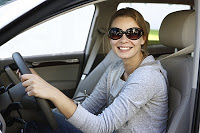Tag Archive: teen defensive driving

5 Teen Driving Safety Tips
January 11, 2011
Tomes can be written about teen driving safety tips but some of the more important ones, are usually the ones that are both the most simple and sometimes-overlooked. Most people know that drinking while driving is never a good idea, regardless of if it is a new driver, or older driver. But there are several other reminders to pass on to family and friends.
Here are a few of the better teen driving safety tips:
Contracts with parents – This is by far the simplest and easiest to do to keep teens safe: maintain a Parent-Teen driving contract or logbook. It could be as simple as a set of dos and don’ts from parents to their teens; along with the appropriate consequences should the teen break any of the terms of agreement. A logbook is helpful to limit access to the vehicle and monitor your teens use and responsibility toward driving and care. Studies show that when teens are not given unlimited access to the vehicle, that they take better care of it and are involved in fewer crashes and receive les tickets. The logbook can be as simple as a teen noting down the times of departure and arrival if the vehicle will be used.
Don’t be a chauffeur – A teen driving safety tip is for teens not to become their friend’s personal driver. Just because a teen is able to drive does not mean they are capable of handling the distraction and responsibility for their passengers. Many states have enacted laws prohibiting learner’s permit holders from having passengers under 21, and for newly licensed drivers limiting passengers as well. More passengers equate to more variables to lose focus on while driving.
Learn from defensive driving, not by driving around – Driver’s education and defensive driving courses are specifically designed to create a controlled environment for new drivers to hone their skills and learn strategies for safe driving. Busy streets are not for learning defensive driving on the fly.
Buckle up! – Teach a teen driver to practice buckling up before even starting the vehicle. Wearing your safety belt reduces your chances of being killed or injured by up to 50 percent. As the driver, it keeps you at wheel and in control of the vehicle, which can help you react to other compounding situations in a crash. For a passenger buckling up reduces their body of being thrown from the vehicle, crashing into the interior of the vehicle or other occupants, and reduces the damage caused internally by the force to their organs. Making a constant habit of buckling up before turning on the ignition will go a long way to ensuring their safety and avoiding a citation.
Distracted Driving Mobile App – Most distracted driving mobile applications are designed to disable a mobile phone’s features while the phone is moving. This is a great way to avoid the temptation to answer the phone or a text while behind the wheel. Another feature for many of these apps is to designate locations through their Global Positioning System (GPS) that are unsafe allowing parents to be notified, should their teen find themselves in those spots.
Vehicle crashes are the number one cause of deaths for teens, make it a priority to raise vehicle safety awareness.

Five Important Reminders for Teen Drivers
January 3, 2011
Teaching teens how to drive is only the first step of becoming a safe driver. To become confident and competent behind the wheel it is important that they learn defensive driving strategies. Whether they have just received their license or have been driving for a year, defensive driving school is an opportunity to brush up on the rules of the road. Even though teens as new drivers are starting off fresh, as new learners, sometimes they need a little reminding.
Here are five important reminders for teen drivers:
- 1. Failing to prepare is preparing to fail. Surveys conducted by several driving safety organizations have yielded the same result: teen drivers think that they are better drivers than other drivers. Preparing to drive means preparing the vehicle for safety and mentally preparing the driver to be focused on driving, and nothing else, when a teen driver gets into the driver’s seat.
- 2. Seeing signs. Ever notice those things by the side of the road sometimes? Those are meant to be followed. Speed limits are put into place not by some arbitrary decision: road engineers have taken the time to study traffic flow in an area to determine by which speed it is best to drive at.
- 3. Undertakers love over takers. It’s easy for a teen driver to lose his or her cool when another driver cuts them off, or overtakes them. Some motorists go so far as driving fast to catch up to the drivers who did it to them. Simple advice: let them go on. It’s not a race and it’s not worth the risk of a ticket or crash.
- 4. Distraction is two letters away from destruction. A teen driver may feel that they can ABSOLUTELY do something else while driving, while statistics and surveys often prove otherwise. Surprisingly, teen drivers fail to acknowledge that having other teens in the car is one of the biggest distractions from driving. Eat/text/call/change tunes BEFORE starting the car.
- 5.Drinking, drugging and driving DO NOT mix. That goes with prescription drugs and over-the-counter medications that may impair driving ability too. Teen drivers often underestimate the effects of alcohol, and what they don’t know is, when they get a DUI, it haunts them for a long time. It follows them when they look for jobs; apply for scholarships or when they are going to pay for car insurance. Not to mention that it also puts themselves and other motorists at risk.
If you area teen or know a teen, share these important reminders for safe driving, Driver education is continuing education, especially during the teen years.
Tips for Teens: Safe Fourth of July Driving
July 2, 2009
Though teens cannot legally celebrate the Fourth of July with alcohol, teen drivers still have to contend with intoxicated drivers on the road. Summer is always a dangerous time for teen drivers; they are at particular risk on holiday weekends.
Risk factors for teens on the road during holiday weekends include:
-Due to their limited driving experience, teens often have difficulty handling emergency situations; for example, they might try to pass a driver who keeps drifting into their lane.
-Teens may have trouble recognizing when other drivers might be impaired and neglect to allow an adequate space cushion between their vehicle and the vehicles of those drivers. For example, they may tailgate a vehicle traveling far below the speed limit.
-Teens often have poor impulse control, which could lead them into playing traffic games with aggressive or impaired drivers, such as racing from one traffic light to another.
-Teens may be so preoccupied with their own driving that they fail to notice the actions of other drivers.
Here are some tips on how to recognize an impaired driver:
-their vehicle is straddling two lanes
-they have a close call, such as nearly hitting a parked car
-they make wide, clumsy turns
-they are traveling well below the speed limit (10 mph or more)
-they are following too closely
-they are braking erratically or stopping at inappropriate places (such as at an intersection with a green traffic light)
-their headlights aren’t on at night, or they leave their turn signal on for a prolonged time
Teens can use defensive driving techniques for safe holiday driving:
-Always wear your safety belt. This is your best defense against impaired drivers.
-Obey the speed limit. Driving too fast means you have less space to respond to hazards.
-Avoid being distracted from watching the road by noisy passengers, loud music, or using a cell phone.
-Maintain an adequate space cushion on all sides between your vehicle and other vehicles. If you notice someone driving erratically, increase your space cushion.
-Observe the behavior of other drivers, but keep your eyes moving; don’t get so distracted that you miss another hazard.
Teen drivers can report possible impaired drivers to local law enforcement, but parents should make sure their teens understand that they must pull off the road and stop before using a cell phone.
